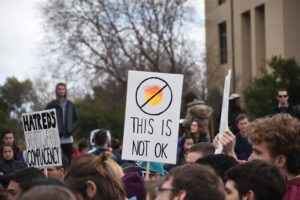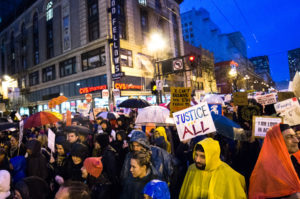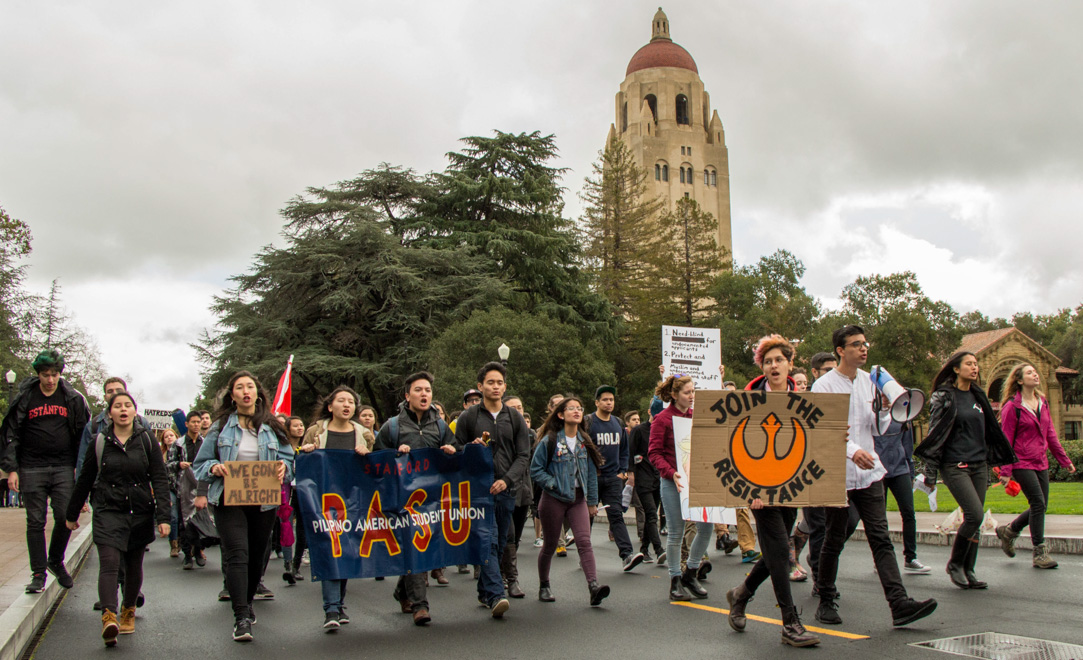On Jan. 20, Donald Trump was inaugurated as the 45th President of the United States. Students, many of whom opposed Trump’s presidency, reacted in a wave of rallies, discussions, marches, art making and prayer, stretching from the Stanford campus to Washington, D.C.
Rally the Resistance
At 11:30 a.m. that Friday, members of the Stanford community filled Meyer Green to speak out against Trump’s inauguration. Named “Rally the Resistance,” the event united many diverse groups on campus, including graduate students and custodial staff. Participants gave speeches, read poems, and led chants amid the rain before the crowd embarked on a march across campus.

The march culminated in a rally outside President Marc Tessier-Lavigne’s office, where students read a list of demands, including that Stanford become a sanctuary campus.
Erin Todhunter, the Resident Fellow in Kimball Hall, came to Meyer Green because she believes that “we just cannot afford to be complacent citizens.” Todhunter added that her “deepest-held values are under assault.”
The idea for the Inauguration Day rally was born out of a mass community action meeting that took place at Stanford in December, in the wake of Trump’s victory.
Sid Patel, a fourth-year Ph.D. candidate in civil and environmental engineering, helped organize the December meeting and Rally the Resistance because he believed a strong, immediate response was necessary.
“I think the best chance we have of restraining Trump and his administration is in building mass social movements and public protests,” Patel said. “I don’t trust the politicians of the Democratic Party to put up an effective opposition.”
The organization of the rally reflected the cooperative goals of the organizers. The Black Student Union was partially responsible for the event, as well as many individual organizers.
Patel noted the strong participation of the graduate student community in planning the Inauguration Day events, compared to usual campus efforts.
The speakers at the rally also represented a variety of experiences and backgrounds. Among the student participants were Ravi Veriah Jaques ’20, who spoke about his mother’s death at the hands of a racist doctor and described the similarities he sees between the U.S. election and politics in Britain, Fatima Ladha ’17, who spoke about Islamophobia in America, and Joriene Mercado ’18, who shared the story of his parents’ journey to America from the Philippines.
Staff members who spoke included janitors’ union leader Inmar Liborio, who spoke out against Trump, and Doroteo García, who read a poem.
After the rally and march in the morning, organizers hosted eight different events throughout the afternoon on topics ranging from militarism to art performances to the role graduate students can play in political organizing on campus. Organizers hoped that the rally and the follow-up events would help community members find ways to continue activist work in the future.
Shook acknowledged that some students might attend the rally as a one-time action, but emphasized that she and other organizers wanted to encourage attendees to stay involved with activist efforts on campus.
“It’s important that we remind the president-elect, his administration, and just our nation at large that yes, he will be president for the next four years, but we will be there every step of the way,” Shook said. “We will be watching what he does, and we will speak up when his policies or his actions in any way infringe on the rights of us personally and of the people that we care about.”
Stanford in Government encourages discussion, reflection
Two hours before the inaugural parade, SIG hosted an Inauguration Day “Coffee and Conversation” event. SIG provided coffee, candies, trivia, games and paper for students to write their hopes for the next four years, in stark contrast to the protests and marches that marked the inauguration for many other Stanford students.
“Ours is a discussion and reflection based event,” explained SIG chair Libby Scholz ’17. “We want people to have a lot of different options today depending on what they need.”
Meredith Manda ’19, co-director of SIG’s public policy forum, hoped that Stanford students from across the political spectrum would feel encouraged to come together and have a discussion. She described the event as “not [having] a political agenda, but more of an open forum for people to voice their ideas.”
Event participants who had strong personal convictions about the inauguration agreed that the discussion-based event was an important precursor to other Inauguration Day actions, rather than a replacement. Joshua Cobler ’20, who went on to attend the Women’s March in San Francisco, said he appreciated SIG’s emphasis on dialogue.
“It’s very important to be able to talk to people and formulate your thoughts on what is even happening before you start acting,” said Cobler.
Genevieve Singer ’20 agreed, stating the importance of building “consolidation and unity” in spite of a president whose campaign had created discord and division.
“For me, at least, it’s more about the event than it is about the man,” explained Matt Galloway ’20, one of the event organizers. “This is reflecting on a peaceful transfer of power, reflecting on the legacy of previous presidents, how Obama’s leaving the White House, what he’s done, just as much as it is about the next four years.”
Marching on Washington
The day after Trump’s inauguration, a group of over 100 Stanford students, alumni and faculty traveled to Washington, D.C. to join the Women’s March. History professors Allyson Hobbs and Estelle Freedman and a group of students had organized the unofficial Stanford cohort attending the Women’s March since November.

Hobbs describes the idea of a Stanford group at the Washington, D.C. Women’s March as a serendipitous collaboration between her and her students. The weekend after the election, her class happened to go on a road trip, and found themselves discussing the effects of the election.
“And from there we just said, how exciting and how wonderful would it be if we could bring together a lot of college students to be able to go to the march?” Hobbs said. “And really right from that moment, at that table at breakfast, that’s where it all started.”
According to Hobbs, the effort to attend was primarily student-driven. The GoFundMe campaign — to fund students who wanted to go but couldn’t afford travel costs — received $5,585, particularly from several Stanford alumni in particular. The group also prepared for the march by circulating their plan so that other students could join them, and learning together about the history of marches and protests.
Kayla Guillory ’18 was one of the student organizers who helped raise and distribute the GoFundMe money.
“Sometimes, even in a super liberal institution like Stanford, you can feel like you’re the only one who still cares about this, like you’re the only one who’s still totally outraged,” she said.
Guillory admitted that she had been a bit nervous before the march, but says that after participating she walked away with “a spirit of optimistic activism,” and is now determined to call her senators and engage in political life more.
Michelle Hull ’19 helped organize the publicity and logistics for students to attend the march. Although she ultimately decided to attend the San Francisco sister march instead, she was enthusiastic about enabling students to travel to the Washington, D.C. Women’s March. Hull stressed the importance of emphasizing diversity within the Women’s March movement, with acknowledgement of her own privilege as a white, straight, upper-middle class woman.
Back on campus, the group plans on coming together again after the march to reflect and discuss future steps. Several members reflected optimism for carrying the momentum from the Women’s March forward.
Hobbs and Freedman noted their optimism after watching the independent manner in which the Women’s March on Washington Stanford group formed, as well as the many students who attended sister marches.
“Students really should be making the decisions, taking the lead,” Freedman said. “It will be in the hands of students to determine their course.”
Contact Sarah Wishingrad at swishing ‘at’ stanford.edu and Sierra Garcia at sgarcia3 ‘at’ stanford.edu.
